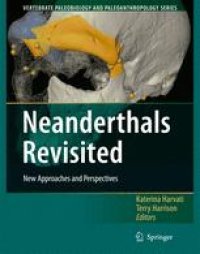
Ebook: Neanderthals Revisited: New Approaches and Perspectives
- Tags: Anthropology, Evolutionary Biology, Vertebrates, Archaeology, Paleontology
- Series: Vertebrate Paleobiology and Paleoanthropology
- Year: 2006
- Publisher: Springer Netherlands
- Edition: 1
- Language: English
- pdf
Recent years have witnessed exciting and important scientific breakthroughs in the study of Neanderthals and their place in human evolution which have transformed our appreciation of this group’s paleobiology and evolution. This volume presents cutting-edge research by leading scientists re-examining the major debates in Neanderthal research with the use of innovative state-of-the art methods and exciting new theoretical approaches.
Topics addressed include the re-evaluation of Neanderthal anatomy, inferred adaptations and habitual activities, developmental patterns, phylogenetic relationships, and the Neanderthal extinction; new methods include computer tomography, 3D geometric morphometrics, ancient DNA and bioenergetics. The diverse contributions offer fresh insights and advances in Neanderthal and modern human origins research.
This is a Volume in The Max-Planck-Institute Subseries in Human Evolution coordinated by Jean-Jacques Hublin, Max-Planck-Institute for Evolutionary Anthropology, Department of Human Evolution, Leipzig, Germany
Recent years have witnessed exciting and important scientific breakthroughs in the study of Neanderthals and their place in human evolution. These discoveries have transformed our appreciation of this group’s paleobiology and evolution. This volume presents the cutting-edge research of leading scientists, re-examining the major debates in Neanderthal research with the use of innovative state-of-the art methods and exciting new theoretical approaches.
Topics addressed include the re-evaluation of Neanderthal anatomy, inferred adaptations and habitual activities, developmental patterns, phylogenetic relationships, and the Neanderthal extinction; new methods include computer tomography, 3D geometric morphometrics, ancient DNA and bioenergetics. The diverse contributions offer fresh insights and advances in Neanderthal and modern human origins research.
Recent years have witnessed exciting and important scientific breakthroughs in the study of Neanderthals and their place in human evolution. These discoveries have transformed our appreciation of this group’s paleobiology and evolution. This volume presents the cutting-edge research of leading scientists, re-examining the major debates in Neanderthal research with the use of innovative state-of-the art methods and exciting new theoretical approaches.
Topics addressed include the re-evaluation of Neanderthal anatomy, inferred adaptations and habitual activities, developmental patterns, phylogenetic relationships, and the Neanderthal extinction; new methods include computer tomography, 3D geometric morphometrics, ancient DNA and bioenergetics. The diverse contributions offer fresh insights and advances in Neanderthal and modern human origins research.
Content:
Front Matter....Pages i-xiv
Neanderthals revisited....Pages 1-7
The distinctiveness and systematic context of Homo neanderthalensis ....Pages 9-22
Saccopastore 1: the earliest Neanderthal? A new look at an old cranium....Pages 23-36
Inquiries into Neanderthal craniofacial development and evolution: “accretion” versus “organismic” models....Pages 37-69
Neanderthals and modern humans — chimps and bonobos: similarities and differences in development and evolution....Pages 71-88
Cranial growth models: heterochrony, heterotopy, and the kinematics of ontogeny....Pages 89-111
Bioenergetic perspectives on Neanderthal thermoregulatory and activity budgets....Pages 113-133
How different were Neanderthals' habitual activities? A comparative analysis with diverse groups of recent humans....Pages 135-156
Neanderthal hands in their proper perspective....Pages 157-190
Did Neanderthals make the Chatelperronian assemblage from La Grotte du Renne (Arcy-sur-Cure, France)?....Pages 191-209
The fate of European Neanderthals: results and perspectives from ancient DNA analyses....Pages 211-219
Selection Selection on mitochondrial DNA and the Neanderthal problem....Pages 221-238
Reliability of cranial morphology in reconstructing Neanderthal phylogeny....Pages 239-254
Non-metric variation in recent humans as a model for understanding Neanderthal-early modern human differences: just how “unique” are Neanderthal unique traits?....Pages 255-268
Earliest Upper Paleolithic crania from Mladec, Czech Republic, and the question of Neanderthal-modern continuity: metrical evidence from the fronto-facial region....Pages 269-279
Neanderthals and modern humans: an example of a mammalian syngameon?....Pages 281-297
Speciation by distance and temporal overlap: a new approach to understanding Neanderthal evolution....Pages 299-314
The Neanderthal-H. sapiens interface in Eurasia....Pages 315-323
Back Matter....Pages 325-333
Recent years have witnessed exciting and important scientific breakthroughs in the study of Neanderthals and their place in human evolution. These discoveries have transformed our appreciation of this group’s paleobiology and evolution. This volume presents the cutting-edge research of leading scientists, re-examining the major debates in Neanderthal research with the use of innovative state-of-the art methods and exciting new theoretical approaches.
Topics addressed include the re-evaluation of Neanderthal anatomy, inferred adaptations and habitual activities, developmental patterns, phylogenetic relationships, and the Neanderthal extinction; new methods include computer tomography, 3D geometric morphometrics, ancient DNA and bioenergetics. The diverse contributions offer fresh insights and advances in Neanderthal and modern human origins research.
Content:
Front Matter....Pages i-xiv
Neanderthals revisited....Pages 1-7
The distinctiveness and systematic context of Homo neanderthalensis ....Pages 9-22
Saccopastore 1: the earliest Neanderthal? A new look at an old cranium....Pages 23-36
Inquiries into Neanderthal craniofacial development and evolution: “accretion” versus “organismic” models....Pages 37-69
Neanderthals and modern humans — chimps and bonobos: similarities and differences in development and evolution....Pages 71-88
Cranial growth models: heterochrony, heterotopy, and the kinematics of ontogeny....Pages 89-111
Bioenergetic perspectives on Neanderthal thermoregulatory and activity budgets....Pages 113-133
How different were Neanderthals' habitual activities? A comparative analysis with diverse groups of recent humans....Pages 135-156
Neanderthal hands in their proper perspective....Pages 157-190
Did Neanderthals make the Chatelperronian assemblage from La Grotte du Renne (Arcy-sur-Cure, France)?....Pages 191-209
The fate of European Neanderthals: results and perspectives from ancient DNA analyses....Pages 211-219
Selection Selection on mitochondrial DNA and the Neanderthal problem....Pages 221-238
Reliability of cranial morphology in reconstructing Neanderthal phylogeny....Pages 239-254
Non-metric variation in recent humans as a model for understanding Neanderthal-early modern human differences: just how “unique” are Neanderthal unique traits?....Pages 255-268
Earliest Upper Paleolithic crania from Mladec, Czech Republic, and the question of Neanderthal-modern continuity: metrical evidence from the fronto-facial region....Pages 269-279
Neanderthals and modern humans: an example of a mammalian syngameon?....Pages 281-297
Speciation by distance and temporal overlap: a new approach to understanding Neanderthal evolution....Pages 299-314
The Neanderthal-H. sapiens interface in Eurasia....Pages 315-323
Back Matter....Pages 325-333
....